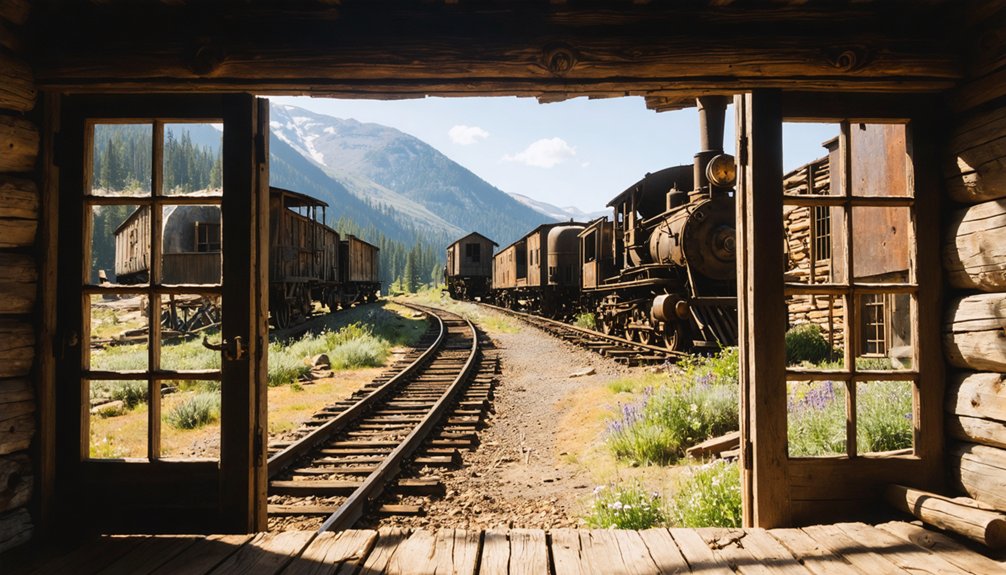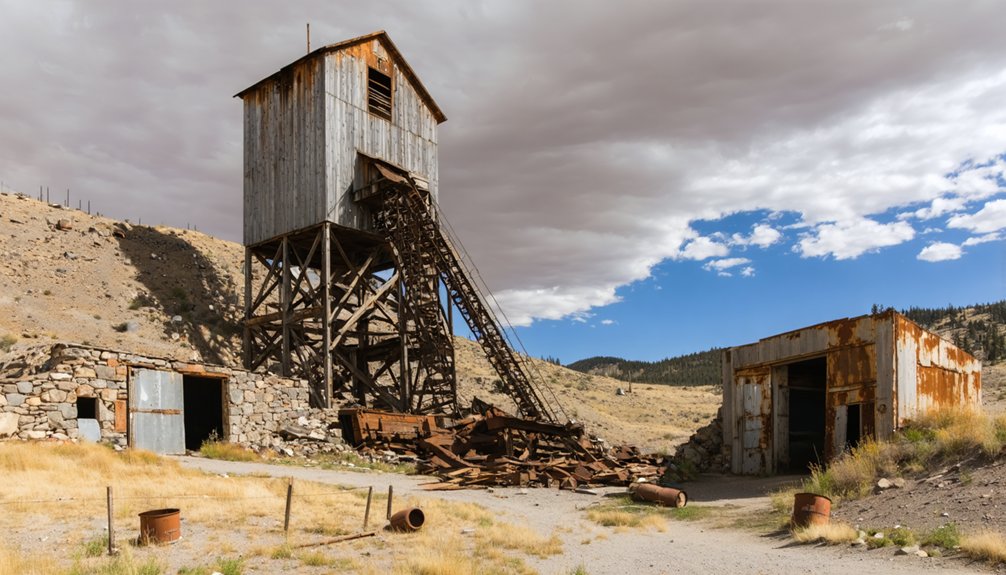You’ll find Eagle City’s remnants near the North Fork of the Coeur d’Alene River, where A.J. Prichard’s 1883 gold discovery sparked a massive rush that drew 5,000 people, including Wyatt Earp. The town boomed with saloons, mining claims, and fierce property disputes before its swift decline. Today, nature has reclaimed most structures, but you can still explore this historic site via Prichard Creek Road – a symbol of Idaho’s dramatic mining era that holds countless untold stories.
Key Takeaways
- Eagle City was established in 1883 after A.J. Prichard’s gold discovery, rapidly growing to 5,000 residents by spring 1884.
- The ghost town site is located near the North Fork of the Coeur d’Alene River, accessible via Prichard Creek Road.
- Notable figures like Wyatt Earp operated businesses and maintained order during the town’s brief but intense gold rush period.
- Visitors can explore remnants of wooden cabins and old graves among forest growth, but no modern facilities exist.
- Spring and summer offer the best visiting conditions, with visitors advised to bring water and safety equipment.
The Discovery of Eagle City’s Gold Rush
Three pivotal events shaped Eagle City’s beginning: A.J. Prichard’s golden discovery in 1883, the sudden influx of determined prospectors, and the rapid development of mining infrastructure.
You’ll find Eagle City’s story nestled within Idaho’s broader gold rush history, following earlier strikes in the 1850s and 1860s that had already drawn fortune-seekers to the territory.
The gold rush impact rippled through the region as miners flocked to this promising new strike near Murray and Coeur d’Alene. They found both placer deposits and quartz veins, making Eagle City a prime location for various mining operations. The Coeur d’Alene region became Idaho’s premier mining area for valuable minerals.
Supply trains soon followed the prospectors, transforming the remote location into a bustling frontier settlement. The discovery opened up Central and Northern Idaho to more systematic mining efforts, creating a network of interconnected mining communities. Exaggerated reports claimed miners could earn up to $40 per day, fueling the rapid population growth to 5,000 residents by spring 1884.
Life in an 1880s Mining Camp
Life in Eagle City’s mining camp reflected the stark realities of 1880s frontier existence, where men labored long hours in search of gold while enduring primitive conditions. You’d find miners working from sunup to sundown, panning river sediments or digging claims, particularly during low water seasons. Wyatt Earp served as deputy sheriff there, managing conflicts between rival prospectors.
Daily routines centered around basic survival and the pursuit of wealth. You’d sleep on “Idaho feathers” – pine boughs covered with blankets – and eat from tin plates in makeshift shelters. The twenty-five cents per pound freight cost for supplies hauled by toboggan men made basic necessities expensive.
The social dynamics revolved around saloons and gambling halls, where figures like Wyatt Earp ran establishments. While white miners claimed the richest deposits, Chinese workers later dominated the workforce as easy gold disappeared.
Merchants and craftsmen – from blacksmiths to bakers – often found steadier income serving the camp than prospecting themselves.
Wyatt Earp’s Time in Eagle City
You’ll find that Wyatt Earp’s role in Eagle City went beyond his saloon business, as he took on the position of Deputy Sheriff for Kootenai County.
During his time here, he handled several heated mining claim disputes, including a tense standoff between rival prospectors that he managed to resolve without bloodshed.
His reputation from Tombstone preceded him, which likely helped him maintain order in our rough-and-tumble mining camp during the height of the gold rush.
With partners like Danny Ferguson and John Hardy, Earp established the White Elephant Saloon which became a prominent local business.
Earp also spearheaded the development of the Trout Creek Trail, employing twenty men to improve transportation routes for miners and supplies.
Earp’s Mining Claim Disputes
When Wyatt Earp and his wife Josephine arrived in Eagle City during the winter of 1884, they stepped into a powder keg of mining claim disputes that would define their brief stay in Idaho’s gold country.
Partnering with Danny Ferguson, John Hardy, Jack Enright, and Alfred Holman, Earp’s mining company quickly found itself in legal battles with A.J. Pritchard, who’d discovered gold in the area two years earlier.
You’ll find court records showing accusations of claim jumping flew both ways, with Pritchard eventually winning at least one lawsuit against the Earps’ group.
The heavy snow that winter didn’t help matters, making it tough to establish clear property lines.
While Earp opened the White Elephant saloon to keep money flowing, the mining disputes ultimately pushed him and his partners out of Eagle City within months. These early conflicts foreshadowed his later success when he staked mining claims in California’s Mojave Desert in 1906.
Earp and his brother Jim also operated a dance hall and saloon together during their time in Eagle City.
Law and Order Role
Beyond his mining interests, Wyatt Earp brought his law enforcement experience to Eagle City’s rough-and-tumble streets. As Kootenai County’s deputy sheriff, he’d step between warring factions during heated property disputes that often erupted into gunfights among miners.
Having previously earned experience as deputy U.S. Marshal in 1877, Earp was well-prepared for maintaining order in mining communities.
You’ll find his name linked to numerous peacekeeping efforts, where he worked alongside fellow lawman W.F. Hunt to maintain order in the frontier settlement.
Like modern family history research, Earp’s approach to recording and documenting local disputes helped preserve important historical records of the era.
Earp’s approach to community relations set him apart – he’d use humor and level-headed dialogue to defuse tense situations rather than force.
With his brother Jim’s support, he earned the miners’ respect through fair-minded mediation of their conflicts. His calm demeanor and collaborative style with local authorities helped establish the stability needed for Eagle City’s development during its brief mining boom.
Mining Claims and Property Disputes
As Eagle City emerged following Andrew Pritchard‘s 1882 gold discovery, fierce battles over mining claims quickly shaped the settlement’s early history.
You’ll find that claim ownership disputes dominated the courts, with Pritchard securing extensive claims early on while facing challenges from newcomers like Wyatt Earp and his partners.
Mining ethics came into question as allegations of claim jumping surfaced, leading to heated legal battles that often halted operations.
- Pritchard won a notable lawsuit against the Earps over illegal claim jumping
- Underground conflicts sometimes erupted in mining tunnels between rival parties
- Court battles frequently suspended mining operations until ownership was established
The intense competition over claims affected production rates and created lasting tensions in the community, though the area continued to see both placer and quartz mining activities despite these challenges.
Notable Characters and Conflicts

The colorful cast of characters who populated Eagle City brought both fame and notoriety to this frontier mining settlement.
Among Eagle City legends, you’ll find Wyatt Earp and his companion Josephine Marcus, who ran a tent saloon during the 1884 gold rush.
Frontier justice played out dramatically through figures like Henry Bernard, the newspaper manager who fatally shot Enright, and the infamous feud between Buzzard and Enright that required sheriff intervention.
You’ll discover that Titus Blessing, an associate from Tombstone, crossed paths with the Earps here, adding to the town’s Wild West reputation.
While Earp attempted to broker peace by persuading rival factions to disarm, his own reputation became tarnished by accusations of “lot-jumping” – a common dispute in these bustling mining camps.
The Rise and Fall of a Frontier Town
Following Andrew Pritchard’s momentous gold discovery in 1882, Eagle City emerged as the pioneering settlement of Idaho’s Coeur d’Alene River mining district.
The community dynamics shifted rapidly as prospectors and miners flooded the area, transforming the wilderness into a bustling tent city. You’d have found Wyatt Earp and his brothers operating a saloon amid the growing collection of crude log cabins and canvas shelters.
- Daily waves of fortune-seekers created an explosive population surge
- Economic factors centered on Prichard Creek’s promising gold deposits
- Murray’s superior location ultimately drew residents and businesses away
Gold Mining Operations and Techniques

Miners wielding picks, pans, and shovels dominated Eagle City’s early gold production landscape, relying primarily on placer mining techniques to extract precious metals from Prichard Creek’s gravels.
You’d find prospectors working in small groups, moving earth and managing water flow through wooden sluice boxes to separate gold from sediment.
Unlike Idaho’s richer mining districts, Eagle City never developed significant hard-rock operations. Instead, you’d see miners focusing on basic placer techniques, digging ditches and diverting mountain streams to wash gold-bearing gravels.
Eagle City miners stuck to simple placer mining, sluicing creek gravels rather than drilling deep into mountain rock like other Idaho boomtowns.
They’d form partnerships to pool resources and defend their claims, though frequent disputes over claim jumping often disrupted operations.
While specific production figures haven’t survived, the early techniques used in Eagle City mirrored those of other successful Idaho camps where millions in gold were eventually recovered.
Exploring the Ghost Town Today
While those early mining methods have long since ceased, modern-day visitors to Eagle City will find a dramatically different landscape than the bustling boomtown of the 1880s.
Today, you’ll discover a remote ghost town exploration site where nature has reclaimed much of the historical settlement. The site lies near the North Fork of the Coeur d’Alene River, accessible via Prichard Creek Road, though you’ll need to navigate carefully during certain seasons.
- Pack water, safety gear, and a camera – there aren’t any visitor facilities on site
- Expect to see sparse remnants of wooden cabins and obscured graves amid the forest growth
- Consider visiting during spring or summer when road conditions are most favorable
Historical preservation efforts focus mainly on documentation, as few physical structures remain standing at Eagle City, unlike its neighbor Murray, which maintains more visible historic buildings.
Environmental Legacy of Mining

You’ll still find traces of mining’s harsh environmental toll on Eagle City’s landscape, with acid mine drainage and heavy metal contamination affecting the local watershed.
The abandoned mining sites continue leaching toxins into nearby streams, threatening both wildlife and downstream water quality in ways similar to other historical mining operations across Idaho.
Local conservation groups have launched restoration projects to remediate contaminated soils and improve water quality, though full recovery of the ecosystem will take decades.
River Water Quality Impact
Since the days of Eagle City’s bustling mining operations, the environmental legacy has left an indelible mark on local river systems.
You’ll find that pollution sources from historical mining activities continue to affect water quality, releasing toxic substances that threaten aquatic life and local ecosystems. These impacts extend far beyond the original mining sites, creating long-lasting challenges for river restoration efforts.
- Heavy metals and harmful chemicals seep into waterways, altering the natural chemistry of rivers
- Fish populations and their migration patterns face disruption from changes in water quality
- Local communities deal with decreased property values and limited recreational opportunities
The river’s degraded condition serves as a stark reminder of Eagle City’s mining past, where the pursuit of mineral wealth came at a significant environmental cost that you can still witness in today’s watershed.
Mining Site Contamination Today
Although Eagle City’s mining operations ceased decades ago, their toxic footprint remains deeply embedded in the landscape today.
You’ll find over 650 containers of hazardous chemicals and abandoned equipment scattered across former mine sites, creating persistent contamination sources that challenge modern environmental regulations. Heavy metals like lead, arsenic, cobalt, and nickel continue poisoning local soils, requiring extensive yard remediation in residential areas.
The cleanup battle rages on, with Idaho seeking $7 million to address the toxic legacy. Former mining companies dispute their share of responsibility while federal and state agencies tackle the massive undertaking.
Despite ongoing efforts to contain mine tailings and excavate contaminated soil, these stubborn pollutants keep disrupting natural recovery, leaving barren hillsides and struggling ecosystems in their wake.
Restoration and Conservation Efforts
Despite decades of neglect, Eagle City’s restoration efforts have gained momentum through partnerships between local historical societies and environmental groups.
You’ll find community involvement driving sustainable tourism initiatives that help preserve what remains of this historic mining settlement while protecting the natural environment.
- Local conservation teams are working to document and stabilize remaining grave sites before they’re lost to time and weather.
- Gold panning activities are being restructured to support both tourism and site preservation efforts.
- Educational programs are being developed to share Eagle City’s rich mining heritage while raising awareness about environmental stewardship.
If you’re interested in supporting these efforts, you can participate in cultural events that help fund ongoing restoration work or join volunteer teams working to protect this piece of Idaho’s mining history.
Eagle City’s Place in Idaho History
Eagle City stands as a tribute to Idaho’s dynamic mining heritage, marking the first gold rush settlement in the Coeur d’Alenes region after Andrew Pritchard’s 1881-1882 discovery.
You’ll find its legacy deeply woven into the fabric of frontier life, from the tent saloons operated by Wyatt Earp to the gunfights that shaped its wild character.
While Eagle City‘s prominence was short-lived, it blazed the trail for Idaho’s mining history, drawing thousands of fortune seekers to the region.
Though Murray eventually eclipsed it as the county seat by 1885, Eagle City’s brief but colorful existence exemplifies the boom-and-bust cycle of Western mining towns.
Today, this ghost town heritage serves as a powerful reminder of the untamed spirit that defined Idaho’s territorial days, where fortunes were made and lost in the blink of an eye.
Frequently Asked Questions
What Was the Average Temperature in Eagle City During Winter Months?
You’ll experience winter climate lows around 24-30°F and highs of 38-45°F, with significant temperature fluctuations throughout the day due to the region’s dry continental conditions.
Did Any Women Own or Operate Businesses in Eagle City?
You won’t find direct historical records of women entrepreneurs in the ghost town period, though it’s possible some operated businesses unofficially. Today’s Eagle stands in stark contrast, with women owning most downtown businesses.
What Indigenous Tribes Lived in the Eagle City Area Before Mining?
You’ll find the Shoshone-Bannock peoples were the primary Native Tribes here, with Northern Paiute and Ute also claiming Cultural Heritage ties to these ancestral lands before mining began.
Were There Any Schools or Churches Established in Eagle City?
You won’t find records of any school history or church activities – the town’s brief existence from 1881-1884 and its transient mining population didn’t support permanent civic or religious institutions.
What Transportation Methods Did People Use to Reach Eagle City?
Like pioneers charting new territory, you’d reach Eagle City using horse-drawn carriages along dirt trails, interurban trolleys after 1907, and the Oregon Short Line Railroad for longer hauls and freight transport.
References
- https://digging-history.com/2014/05/28/ghost-town-wednesday-eagle-city-idaho/
- https://exhibits.lib.utah.edu/s/ghost-towns/item/140116
- https://www.eaglemagazine.com/15-historical-facts-about-eagle/
- https://history.idaho.gov/wp-content/uploads/2018/08/0064.pdf
- https://www.idahomagazine.com/article/as-wild-west-as-it-gets/
- https://www.ghosttowns.com/states/id/eaglecity.html
- https://en.wikipedia.org/wiki/Eagle_City
- https://www.historynet.com/ghost-towns-burke-idaho/
- https://history.idaho.gov/wp-content/uploads/2018/08/0009.pdf
- https://accessgenealogy.com/idaho/discovery-of-gold-in-idaho.htm



